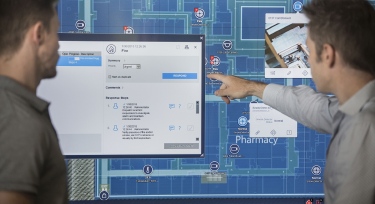Seeing, swiping and tapping is believing
Why should the simplicity and ease of use of devices such as smartphones and tablets stop when a facility manager or executive starts his day’s work? Graeme Laycock of Honeywell believes it shouldn’t — a philosophy behind the development of the company’s Command Wall.
Your day likely starts with a technology-heavy ritual that includes scrolling through email via your smartphone and, with an additional swipe, effortlessly checking the day’s weather. Perhaps you’re travelling on business so you ask your phone where the nearest coffee shop is and set off using GPS to address your nagging caffeine fix.
All this happens without much thought or effort. In many ways, we’ve come to take this level of convenience and visibility into our surroundings for granted.
When a facility executive or manager heads off to their job, should this seamless and effortless use of technology suddenly stop? The answer is ‘no’, but that’s different to the reality presented by much of the software and many of the systems currently used to power buildings. Regardless, employees are coming to expect the same mobility, ease-of-use and simplicity they find on their personal smartphones and tablets. And the building controls industry is starting to shift accordingly, with the same concepts and principles that make consumer products intuitive and indispensable seeping into facility technology.
Call it the Apple-isation of the industrial world.
Fortunately, this is not change for change’s sake. Facility professionals who embrace this trend and the underlying tenets — improved data mining, visualisation and user experience — can help improve processes and operations to drive meaningful business outcomes.
Adopting design-led technology is all about making things simple, engaging and easy to understand. In a facility environment, this translates into building-automation control features like map-based visualisation and touchscreen interfaces. It also means leveraging the interconnectedness of today’s smart buildings to help manage occupant activity and use of space more intelligently.
Intuitive design can benefit other areas as well, such as reducing system training time to speed on-boarding and minimising operator error. The goal is to make the learning curve slight, if not erase it altogether. Imagine a building-management system that’s only accompanied by a short start-up guide. The technology would no longer be the exclusive domain of facility personnel. Operations and management teams would also be able to easily access and understand data such as energy use and security alarm patterns, turning the building into a driver of efficiency and business continuity.

Building controls designed with the user experience in mind should inherently be more ‘visual’, much like today’s smartphone and tablet operating systems. By quickly aggregating system data across a facility and presenting it to operators along with suggested improvements that can be automatically implemented, technology can help pave the way for faster and better-informed decision making.
For example, with enhanced visualisation, first responders can easily investigate alarms, view the areas that might be at risk and map the most safe, efficient routes to and from those zones if necessary — all without setting foot in a facility.
Smart buildings can exist without a well-designed user experience, and a number of building functions and processes certainly happen automatically as a result of intelligence and integration. However, layering on technology to help drive an enhanced user experience can provide the holistic, actionable and intuitive view one needs to derive maximum value from a building’s performance.
Whether benefiting productivity in a government facility, monitoring crowd levels in an airport line to help determine the necessary staffing, or helping enhance security in a hospital, keeping the user experience in mind can help improve even the most seemingly well-run buildings to deliver that much more value.
Buildings are critical to a business and can help it meet its strategic objectives when the right tools and technologies are in place. Today, the consumerisation of building technologies is helping facilitate these improvements, enabling facility executives and managers to truly put their buildings to work and help meet organisational goals.
Graeme Laycock is experience design fellow with Honeywell.







